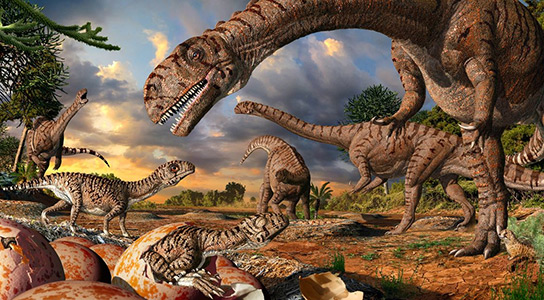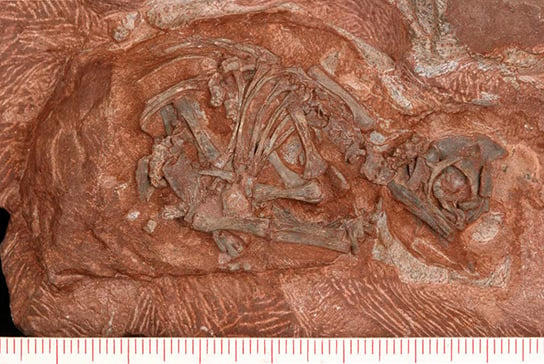
Clutches of eggs and tiny dinosaur footprints found at a recently unearthed excavation site reveal that dinosaurs may have remained at their nesting site for long enough after hatching to double in size. At 190 million years old, this Massospondylus (a genus of prosauropod dinosaur) “nursery” is the oldest dinosaur nesting site ever discovered.
An excavation at a site in South Africa has unearthed the 190-million-year-old dinosaur nesting site of the prosauropod dinosaur Massospondylus-revealing significant clues about the evolution of complex reproductive behavior in early dinosaurs. The newly unearthed dinosaur nesting ground predates previously known nesting sites by 100 million years, according to study authors.
A new study led by U of T Mississauga paleontologist Robert Reisz, with co-author David Evans of the Royal Ontario Museum and a group of international researchers, describes clutches of eggs, many with embryos, as well as tiny dinosaur footprints, providing the oldest known evidence that the hatchlings remained at the nesting site long enough to at least double in size.

At least ten nests have been discovered at several levels at this site, each with up to 34 round eggs in tightly clustered clutches. The distribution of the nests in the sediments indicate that these early dinosaurs returned repeatedly to this site, a behavior known as “nesting fidelity,” and likely assembled in groups to lay their eggs, (“colonial nesting”), the oldest known evidence of such behavior in the fossil record. The large size of the mother, at six meters in length, the small size of the eggs, about six to seven centimeters in diameter, and the highly organized nature of the nest suggest that the mother may have arranged them carefully after she laid them.
“The eggs, embryos, and nests come from the rocks of a nearly vertical road cut only 25 meters long,” says Reisz, a professor of biology at U of T Mississauga. “Even so, we found ten nests, suggesting that there are a lot more in the cliff, still covered by tons of rock. We predict that many more nests will be eroded out in time as natural weathering processes continue.”
The fossils were found in sedimentary rocks from the Early Jurassic Period in the Golden Gate Highlands National Park in South Africa. This site has previously yielded the oldest known embryos belonging to Massospondylus, a relative of the giant, long-necked sauropods of the Jurassic and Cretaceous periods.
“Even though the fossil record of dinosaurs is extensive, we actually have very little fossil information about their reproductive biology, particularly for early dinosaurs,” says David Evans, associate curator, Vertebrate Palaeontology at the Royal Ontario Museum. “This amazing series of 190 million-year-old nests gives us the first detailed look at dinosaur reproduction early in their evolutionary history, and documents the antiquity of nesting strategies that are only known much later in the dinosaur record.”
An exhibition currently on display at the Royal Ontario Museum (ROM) until May 2012, Dinosaurs Eggs and Babies: Remarkable Fossils from South Africa features the oldest fossilized dinosaur eggs with embryos ever found, as well as other impressive discoveries
The study, co-authored by Drs. Hans-Dieter Sues (Smithsonian Institute, USA), Eric Roberts (James Cook University, Australia), and Adam Yates (University of the Witwatersrand, South Africa), is published in the Proceedings of the National Academy of Sciences.